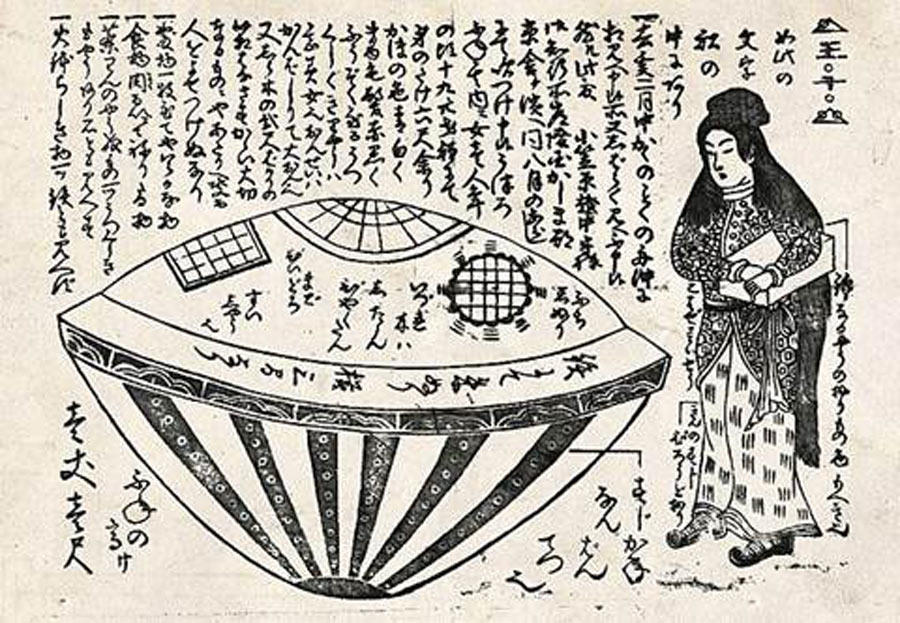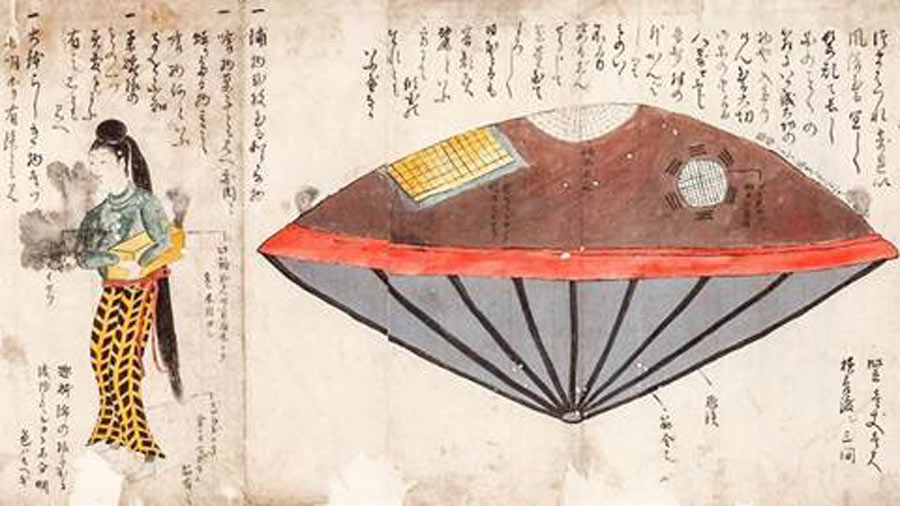Most stories of UFO encounters come from a single source. Either an individual, or a small group of people, witness something they cannot describe and come away from what they, at least, are convinced is an extraterrestrial encounter.
However, throughout history there are occasional accounts of encounters with apparent aliens which are much more widely attested. One such is the story of Utsuro-Bune, the “Hollow Ship” of Japan. Several stories of a “hollow ship” washing ashore on the shoreline of a town in Hitachi province (today’s Ibaraki Prefecture) surfaced in early nineteenth-century Japan.
As per the accounts, the craft was solidly built and had transparent windows. An attractive young woman came from the interior of the craft and approached the onlookers, but she was unable to speak in Japanese, and the people eventually helped her return to her vessel, which then departed.
Several Kawaraban (“tile block printing”) newspapers from the 19th century tell quite similar versions of the legend. Toen Shōsetsu (Tales from the Rabbit Garden, 1825), Hyōryū kishū (Stories from Drifters, around 1835), and Ume-no-chiri (Dust of the Plum, 1844) are the three most well-known.
The descriptions are extremely specific, even down to the young woman’s attire: she was carrying a white box and wearing velvet leggings. Some believe her saucer-shaped boat was a UFO, calling it “Utsuro-Bune” (hollow ship).
Some, pointing to Japan’s cultural isolationism at this point, conclude that this was simply a European ship, and a European woman who arrived on a Hitachi beach, possibly a spy. Others refuse to accept that a mere foreigner would lead to the published descriptions, and believe it was a goddess and even an alien.
The Toen Shōsetsu Account
The story starts on February 22, 1803. Local fishermen on the Harayadori beach in the Hitachi region were working on their nets when they witnessed what they described as a “ship” drifting in the waves.

As the ship drifted closer they could see it was not large and they were able to haul the craft back to shore. Once beached, they described it as 3.3 meters (10.8 feet) tall and 5.5 meters (18 feet) wide.
The upper part appeared to be made of red-coated rosewood, and the lower part was covered with brazen plates. Several windows on the upper part were made of glass or crystal, covered with bars, and were clogged with some kind of tree resin.
The inside side of the Utsuro-Bune was painted with inscriptions written in an unknown language, and the hollow craft was described as looking like a Khako, a traditional Japanese incense burner, or a wooden rice pit. Two-bed sheets, a bottle filled with several liters of water, some cake, and some beef were among the goods discovered by the fishermen.
- The Edmonton UFO and the Copper Plate: Can YOU Crack the Code?
- Controversial Yonaguni Monument of Japan
The fisherman then noticed a lovely young lady, probably 18 or 20 years old. Her height was estimated to be 1.5 meters (5 feet). The woman had red hair and brows, which appeared to be artificially lengthened with white extensions made from white fur or tiny, white-powdered textile streaks.
This peculiar appearance does not sound familiar to either Japanese or other historical descriptions of the 19th century. The lady’s complexion had a pale pink tone, she carried a box in front of her which she refused to allow anyone else to touch, and she wore rich, expansive, and smooth garments made of unfamiliar textiles.
The woman began to talk, but no one could understand what she was saying. The local village elder was consulted, and speculated that this woman could be a princess of a foreign realm who married in her country, and that this was not, in fact, the first of these occurrences.
A very similar artifact with a woman had washed up on a nearby beach in the past. In this earlier incident, a little board with a human head pinned to it was discovered during this occurrence, with the earlier woman as protective of the head is this current visitor was of her box.
The village elder speculated that the woman might have been banished for marrying against her father’s will, and that her lover had been killed as punishment. Investigating the woman and her boat further would have been difficult and time consuming, and so the decision was made to carry the woman back to the Utsuro-Bune and let her drift away.
It is unclear whether the woman was actually returned to the floating craft, however. In some stories she returns to her apparent punishment and drifts away with the vehicle, never to be seen again. In another story, the lady from the empty boat stays and grows old where she landed. However, nothing else is ever found out about Utsuro-Bune.
Was it a UFO?
Tanaka Kazuo, a professor at Gifu University in Japan, is a leading researcher on Utsuro-Bune, of which several examples exist in Japanese history. Tanaka says he started looking into the ship after the Aum Shinrikyo cult’s horrific subway sarin bombings in 1995.
Aum founder Asahara Shoko’s prophecies and claims to be able to float in the air received a lot of attention at the time. The cult’s senior members, on the other hand, were members of the scientific elite.
He began presenting lectures on paranormal events through a scientific lens, which required him to gather a variety of materials for teaching, such as information on UFOs in the United States. He discovered the Japanese stories of Utsuro-Bune, which occurred far earlier than any US close encounters, while doing so.

Tanaka observed that the depictions of Utsuro-Bune made at the time resembled modern-day accounts of flying saucers. Could this 19th century visitor to Japan have truly been an alien?
- Madonna with Saint Giovannino: Painting with a UFO?
- Land of the Rising Sun: Did Jesus Retire To Rural Japan?
However, Tanaka notes the hopelessness of truly understanding what the villagers saw, and what the Utsuro-Bune really was. No wreckage or alien remains survive the account to be analyzed: all that was left was the ambiguous testimony of witnesses.
This is far from atypical for UFO encounters, as all the other UFO reports from throughout the world lack solid evidence. What the Utsuro-Bune stories have, on the other hand, are many documents to investigate as leads, something for researchers to look into.
Other Stories and Recent Findings
There is other documentation about Utsuro-Bune sightings in Japan, such as an 1825 depiction in “Hirokata Zuihitsu” and another an around the same time in “Oshuku Zakki”. These texts contain drawings of circular, disc-shaped craft of unknown manufacture, which look like nothing so much as flying saucers.
Examinations into what these pictures portray began in 1844, and were carried out again in 1925 and 1962. No conclusion explanation has yet been provided as to what they depict, and the debate continues.
Kazuo Tanaka discovered and researched two uncommon ink printings in 2010 and 2012. They had accounts of Utsuro-Bune in 1977 that were extremely similar to those in the Hyōryū kishū, except they located the event somewhere else.

But could this be a lot of fuss over nothing? Yanagida Kunio, the historian responsible for the 1925 and 1962 studies of Utsuro-Bune, points out that circular boats have been common in Japan since ancient times; only the western-style elements, such as the glass windows and brazen defensive plates, give the Utsuro-Bune a foreign appearance.
He also discovered that most legends identical to the Utsuro-Bune sound the same: someone discovers a strange girl or young lady within a circular boat and rescues or returns her to the sea. Yanagida further points out that the earliest versions of Utsuro-Bune describe simple, open log-boats with no dome on top.
Are these women banished to the sea for an illicit romance, carrying the head of their lovers with them until they are lost? For some, this is all the explanation that is needed.
But who, then, is banishing them? We have only the stories of those who find the craft, never those who condemn the women placed onboard to banishment. Why the strange, European features if the round craft are part of a Japanese tradition?
To the villagers who found the craft in 1803, the woman was certainly from another world. Whether a terrestrial or an extraterrestrial one, has never been conclusively proven.
Top Image: Could the Utsuro-Bune be a spacecraft? Source: Miguel Aguirre / Adobe Stock.
By Bipin Dimri